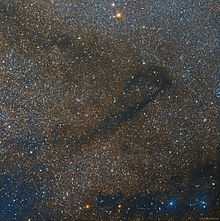Alpha Vulpeculae

| |
| Observation data Epoch J2000.0 Equinox J2000.0 | |
|---|---|
| Constellation | Vulpecula |
| Right ascension | 19h 28m 42.330s[1] |
| Declination | +24° 39′ 53.65″[1] |
| Apparent magnitude (V) | 4.44 |
| Characteristics | |
| Spectral type | M0III |
| Astrometry | |
| Proper motion (μ) | RA: –126.13 ± 0.19[1] mas/yr Dec.: –107.44 ± 0.22[1] mas/yr |
| Parallax (π) | 10.97 ± 0.28[1] mas |
| Distance | 297 ± 8 ly (91 ± 2 pc) |
| Absolute magnitude (MV) | –0.36 |
| Other designations | |
Alpha Vulpeculae (Alpha Vul, α Vulpeculae, α Vul) is the brightest star in the constellation Vulpecula. It has a traditional name, variously represented as Lukida, Lucida Anseris, or Anser, a tradition kept from when the constellation had the name Vulpecula et Anser 'the fox and the goose'.
Alpha Vulpeculae is a red giant of spectral class M0 and has apparent magnitude +4.44. It is approximately 297 light years from Earth. It forms a wide optical binary with 8 Vulpeculae.
It has been analysed as a member of the Arcturus stream, a group of stars with high proper motion and metal-poor properties thought to be the remnants of a small galaxy consumed by the Milky Way.[3]

Amateur image of LDN 778 (center) and Alpha Vulpeculae, (red giant, top center).
See also
References
- ↑ 1.0 1.1 1.2 1.3 1.4 van Leeuwen, F. (2007). "Validation of the new Hipparcos reduction". Astronomy and Astrophysics 474 (2): 653–664. arXiv:0708.1752. Bibcode:2007A&A...474..653V. doi:10.1051/0004-6361:20078357.Vizier catalog entry
- ↑ "HD 20781 -- High proper-motion Star". SIMBAD Astronomical Database. Centre de données astronomiques de Strasbourg. Retrieved 2014-09-13.
- ↑ Eggen, Olin (1971). "The Arcturus Group". Publications of the Astronomical Society of the Pacific 83 (493): 271–85. Bibcode:1971PASP...83..271E. doi:10.1086/129120.
External links
- Alpha Vulpeculae on WikiSky: DSS2, SDSS, GALEX, IRAS, Hydrogen α, X-Ray, Astrophoto, Sky Map, Articles and images
| ||||||||||||||||||||||||||||||